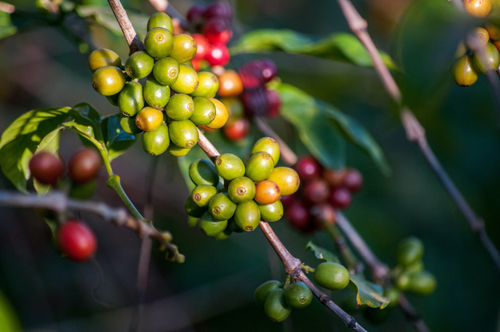Coffee From Farmer To Cups

Coffee! The ultimate beloved beverage, hot or cold, stays in high demand during all the seasons.
What comes to mind when you think of COFFEE?
Specifically about its shape?
Mostly you think of brown coffee beans or ground brown-colored coffee.
A majority of the people don’t know that COFFEE is not produced as brown beans.
Instead, coffee beans are the seeds of red cherries growing on trees.
These seeds pass through many complex procedures to produce a finished product of brown roasted beans.
Let’s observe this journey to appreciate the effort to achieve a perfect cup of coffee.
I.PLANTING/ FARMING COFFEE PLANTS
Coffee plants prosper from planting unprocessed coffee seeds.
The seeds are planted under shade and watered regularly to produce a fragile coffee plant in a nursery.
The young saplings are left for a few days to become strong enough to shift to a permanent position like farming soil.
Such coffee plants may take 2 to 4 years to flower after planting.
The flowers of these plants produce the COFFEE CHERRIES that ripen after an estimated 8 months and change color from green to red.
Did you know RAINY SEASON is considered optimal for Coffee planting?
That’s because the plant roots get firmly established with moist soil.
During this farming phase, a planter/farmer has to observe many factors for plant maintenance:
- Pests
- Soil moisture
- Acidity of soil
- Nutrient content of soil etc.
II.HARVESTING THE COFFEE CHERRIES
The commonly seen brown coffee beans are still a long way to come!
Coffee plants have produced their fruit called CHERRIES.
Now there is a need to harvest these cherries.
WAYS OF HARVESTING
For harvesting, Hand-picking is employed where people need to carefully check cherries for ripeness before removing them.
It’s much time and effort-consuming; thus, it is paid labor.
There are TWO basic methods:
1)STRIP PICKING:
The cherries are picked off the branch, either by hand or machine.
These cherries are machine harvested in large flat-farm surface countries like BRAZIL.
- SELECTIVE PICKING
In SELECTIVE picking, the red cherries are picked, and the green ones are left to ripen.
Picking is carried out at 10-day intervals or at least 3 sweeps of a single farm for total harvesting.
High-quality Arabica coffee gets sorted mostly using the selective approach.
NUMBER OF HARVESTING SEASONS
One harvest season in a year is usually planned globally.
Major Coffee countries like Kenya and Colombia have two harvesting seasons; a main and a secondary crop.
Good roasters know to buy their coffee during mid-season as the taste is not that nice of cherries harvested during the start and end of a harvest season.
III.PROCESSING
After being picked, it’s best to process the harvested cherries quickly to avoid any spoilage.
There are 3 methods here:
1)DRY/NATURAL METHOD
It’s a famous ancient method of processing cherries in countries where water is scarce.
Small-scale farms use this method generally.
Here, the fresh cherries are spread out on a large surface and left to dry in the sun for 15 to 20 days.
The drying process may take several weeks until picked cherries have less than 11% moisture content.
Through drying, the outer skin can be easily removed.
2)WET METHOD
By water, cherries get cleaned and sorted as unripe and overripe.
These cherries are then put through a pulping machine that squeezes the skin without damaging the beans.
The pulping process leaves mucilage.
This sticky stuff is added to tanks having enzymes that remove it, and the resulting naked beans are then dried in the sun.
3)HONEY/ SEMIDRY METHOD
Though the skin and pulp of the cherry are removed mechanically, the sticky mucilage is left on the beans.
It looks and feels like honey.
1-3 weeks are required for drying with the sugars from the mucilage getting coated on the bean.
Hulling, Polishing, and Grading are further minor steps in processing.
IV. ROASTING
Roasting is adding heat until the beans taste good.
A precise recipe gets created by balancing heat, airflow, and time that highlights each bean’s best flavors while avoiding negative ones.
V. GRINDING/PACKAGING
The type of coffee bean grinding in use determines how fast the coffee can release its flavors and depends on the brewer type utilized.
Ground coffee needs to be packed in air-tight containers as exposure to air causes flavor loss in such ground coffee.
PARTING NOTE
Koffee-Express offers you a wide range of premium coffee blends.
Each coffee bean is meticulously planted, harvested, and processed from farmer to cup.





